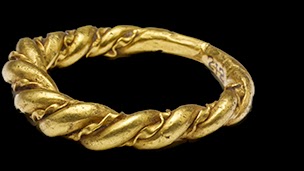If you read this article before June 22nd 2014 and you are in London, hurry up to the British Museum to see one of the most complete exhibition in the world on the Vikings. If you missed it here are some interesting learnings that inspired me.
Inhabitants of the Scandinavian peninsula around the year 700 AD, the Vikings were fascinated with the sea and were driven by an unstoppable desire to discover new lands and places. Probably the main reason was material: starting with the vital wood for their boats to the precious metals and slaves. In fact an initial drive for survival in harsh climate conditions that evolves into an interesting appetite for wealth, power and possession.
In fact their sailing ships mirrored their leaders’ egos. The largest ever ship measured over 37 meters on display in the exhibition. Their fleet had different size of boats that allowed them to face the daring waves of the Atlantic Ocean on their trip to Iceland, Greenland, North America, Spain to the south or the still waters of the large Russian rivers opening them routes to the heart of the Byzantine Empire to Constantinople, the Arab caliphates, stretching to the high lands of Afghanistan.
From Dublin to Kiev
I was impressed to see copy-paste versions of Viking women jewelries excavated in Dublin, Kiev or northern Russia made with Arabian dirham or Afghan coins. The shuffle of goods Vikings produced over 1000 years ago is mind-blowing even for today’s people. In some cases they looted, killed, destroyed and moved on, in other places they settled. Dublin is a clear example of that. Curiously, the Norwegian embassy in the leafy neighborhood of Dublin called Ballsbridge was built over an ancient Viking burial place.
The Story of the Headless Bodies
The exhibition is displaying in a tucked corner, in the shadow of the big boat the human remains of a Viking crew of warriors that had been defeated in Britain. The scientific investigation depicted the fact that the men came from different places in Scandinavia and Denmark, that they were up in their 30s, early 40s and that some of them were limping due to untreated leg infection or accidents. The drama of the scene is increased by their sad fate: they were decapitated and the heads were put together. Further research showed that they did not have their hands tighten up and while their punishment was applied few tried to defend themselves loosing parts of their hand. Not all the heads were found. Probably some of them were displayed in inhabited places.
Killing the Sword
Another interesting practice was “killing the sword”. After a man passed away, his sword would have been bent or rolled and buried. The practice has several hypothesis: avoiding robbers vandalize the graves or simply considering the sword as a prolongation of the human being and his spirit that once the person died, the instrument need to die too.
Picking the Faith
Through their travels the Vikings came in contact with the three big religions: Christianity, Judaism, Islam but they went for the first one in 965 in Denmark (Harald Bluetooth). This choice allowed them more convenience in organizing better their territories, power and influence. The Norwegian rule in the British isles lasted pretty late: in Scotland til 1266, in Orkney til 1468 or in Shetland until 1469.
But nevertheless their legacy is present in Gaelic or English (words like “egg” or “sister”), in the carved crosses, names.
Blondes or Brunettes?
In Ireland the first Viking boat lands in 795 on the island of Dalkey. The Vikings arrive from 2 directions: from the south (from Denmark) and from the north (from Norway). The town of Baldoyle’s name comes from Baile Dubh Ghaill – “the town of the dark foreigners” – the Vikings from Denmark. Those from Norway were called fionn ghaill (white haired foreigners).
Viking Dublin
Ever wondered why Nassau Street in Dublin is almost 2.5 meters above the game field of Trinity College? On the grounds of Suffolk Street used to be a 12 meter high construction made by the Vikings called the Thingmote in the shape of a flat top hill – home of the Parliament where laws would have been promulgated. It was leveled in 1681, creating Nassau Street, now protected from flooding.




